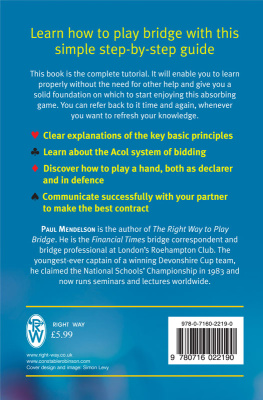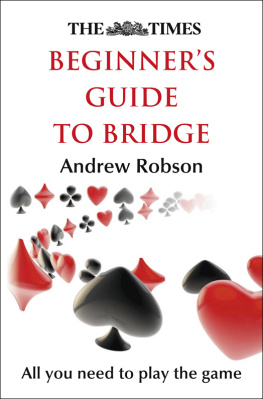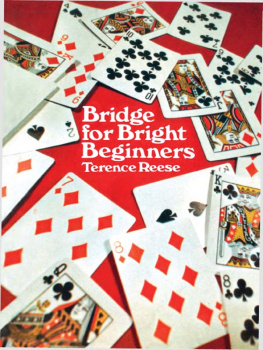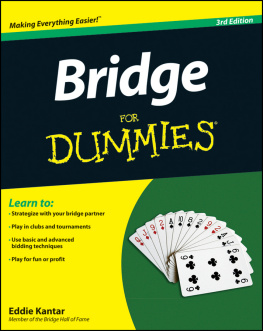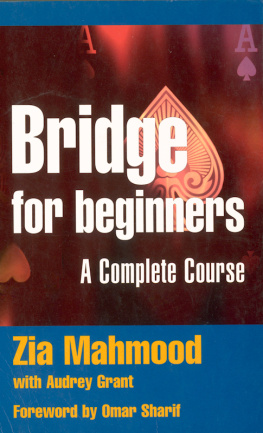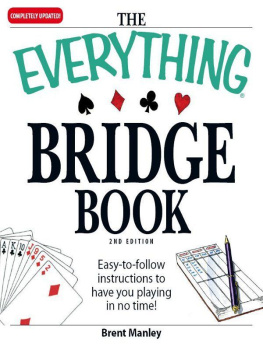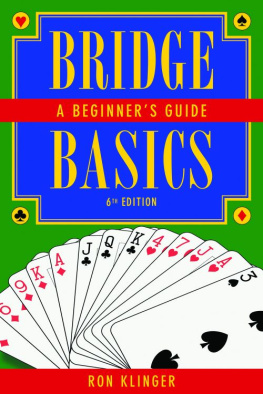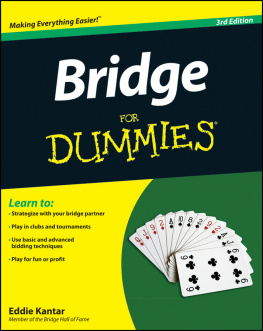APPENDIX
Attitude The play of a card to tell your partner whether you like a particular suit. Traditionally, a high card is encouraging and a low card is discouraging.
Blackwood Convention Once you have agreed on a trump suit, a bid of 4NT is conventional (artificial) and asks partner how many aces are in partners hand.
Broken Sequence Two touching high cards followed by a gap and then the next highest card. For example K Q 10 or Q J 9.
Contract The final bid in the auction that commits declarers side to take the specified number of tricks in the strain named.
Convention A call that conveys a meaning other than the one that would normally be attributed to it. For example, the use of 2 to ask opener for a four-card major (Stayman) in response to an opening bid of 1NT.
Cover Playing a higher card than the one led. For example, playing the king when an opponent leads the queen or the jack.
Crossruff Ruffing losers in both declarers hand and dummy and thus using the trump cards separately.
Dangerous Opponent The opponent that declarer wants to prevent from gaining the lead, either because that opponent has established winners or can lead a card that would trap one of declarers or dummys high cards.
Declarer The player for the side that won the contract who first bid the strain named in the contract.
Defense, Defenders The side that did not win the contract.
Discard The play of a card, other than a trump, of a different suit than the suit led.
Discarding a Loser Playing a losing card on a potential winning card in another suit.
Distribution The number of cards held in each suit by a particular player; the number of cards held in a particular suit by a partnership.
Draw Trumps To lead trumps until the opponents have none left.
Drive Out (a high card) To lead a suit and force an opponent to play a high card to win the trick.
Duck To play a low card from both hands and surrender a trick that could have been won, usually with the object of preserving an entry.
Entry A card that provides a means of winning a trick in a particular hand.
Equals Cards with the same trick-taking potential. For example, the ace and the king in a suit held by the same player.
Establish To make one or more cards in a suit into winners by forcing out the opponents higher cards.
Favorably Divided Having the outstanding cards in a suit divided the way the declarer would like them to be as evenly as possible.
Finesse An attempt to win a trick with a card that is not as high as one held by an opponent by playing the card after that opponent has played.
Fourth Highest The fourth highest card of a long suit (counting down from the top). Also referred to as fourth best.
Grand Slam A contract to take 13 tricks.
Holding The cards one is dealt in a particular suit or in the entire hand.
Hold-up Play Refusal to win a trick you could win in order to make it difficult for the opponents to take tricks. You break their communication and strand their winners in one hand.
Honor Sequence Two or more honor cards in consecutive order of rank. For example, the K and the Q.
Jacoby Transfer Bid A conventional response to an opening bid of 1NT where 2 shows hearts and 2 shows spades. Similar responses can be used over other notrump opening bids.
Lead The first card played to a trick.
Length The number of cards held in a particular suit, often implying five or more.
Like a Suit To have high cards in the suit and/or to want the suit led or continued.
LHO Left-hand opponent, the player on your left.
Lose Control Have no trumps left when the opponents get the lead and start taking their winners.
Loser A card in declarers hand (or dummy) that could lose a trick to the opponents.
Maintain Control Have a sufficient number of trumps to prevent the opponents from taking enough tricks in their suits to defeat your contract when they get the lead.
Overruff To play a higher trump than one played by an opponent when you are void in the suit led.
Overtake Play a higher card than the one already played by your side, usually for the purpose of creating an entry.
PLAN The four basic steps that declarer goes through before starting to play a hand.
Promotion The increase in the trick-taking potential of a card as the higher-ranking cards in the suit are played.
Quick Loser A trick the opponents can take as soon as they gain the lead.
Repeated Finesse A finesse that can be taken more than once.
RHO Right-hand opponent, the player on your right.
Ruff(ing) To play a trump on a trick when youre void in the suit led.
Sacrifice To give up a trick with the hope of getting one or more in return; to bid too high to prevent the opponents from playing in the contract of their choice.
Safe Suit A suit that can be led without giving an opponent a trick that the opponents are entitled to.
Second Hand The player who plays the second card to a trick.
Sequence Two or more cards in the same suit in consecutive order or rank. For example, the king, the queen and the jack.
Side Suit A suit other than the trump suit.
Slow Loser A trick the opponents can take eventually but not immediately, since declarer has one or more winners left in the suit.
Small Slam A contract to take 12 tricks.
Stayman Convention A conventional (artificial) response of 2 to an opening bid of 1NT, asking opener to bid a four-card major suit.
Strong Two-bid An opening suit bid at the two level which shows at least 22 points and is forcing to game.
Sure Trick A trick which can be taken without giving up the lead.
Third Hand The player who contributes the third card to a trick; the partner of the player leading to a trick.
Trap (a high card) A position where a high card cant win a trick because the opponent next to play has a higher card.
Trump The suit named in the contract.
Two-way Finesse The choice within a suit of which way to finesse for a missing card. For example, AJ4 opposite K103.
Unfavorably Divided Having the outstanding cards in a suit divided the way the declarer would not like them to be as unevenly as possible.
Winners Sure tricks declarer can take without giving up the lead.
Probabilities of Suit Divisions
| Two cards are missing | Three cards are missing |
| 1-1 | 52% | 2-1 | 78% |
| 2-0 | 48% | 3-0 | 22% |
| Four cards are missing | Five cards are missing |
| 2-2 | 40% | 3-2 | 68% |
| 3-1 | 50% | 4-1 | 28% |
| 4-0 | 10% | 5-0 | 4% |
| Six cards are missing | Seven cards are missing |
| 3-3 | 36% | 4-3 | 62% |
| 4-2 | 48% | 5-2 | 31% |
| 5-1 | 15% | 6-1 | 7% |
| 6-0 | 1% | 7-0 | 1% |
| An even number of cards rates to divide unevenly (except with two cards missing). | An odd number of cards rates to divide as evenly as possible in all cases. |
ARE YOU A MEMBER?
The American Contract Bridge League (ACBL) is dedicated to the playing, teaching and promotion of contract bridge.
The membership of 160,000 includes a wide range of players from the thousands who are just learning the joy of bridge to the most proficient players in North America. The ACBL has long been the center of North American bridge activity. The organization is looking forward to celebrating its 75th Anniversary in 2012. ACBL invites you to join in the excitement of organized bridge play.


